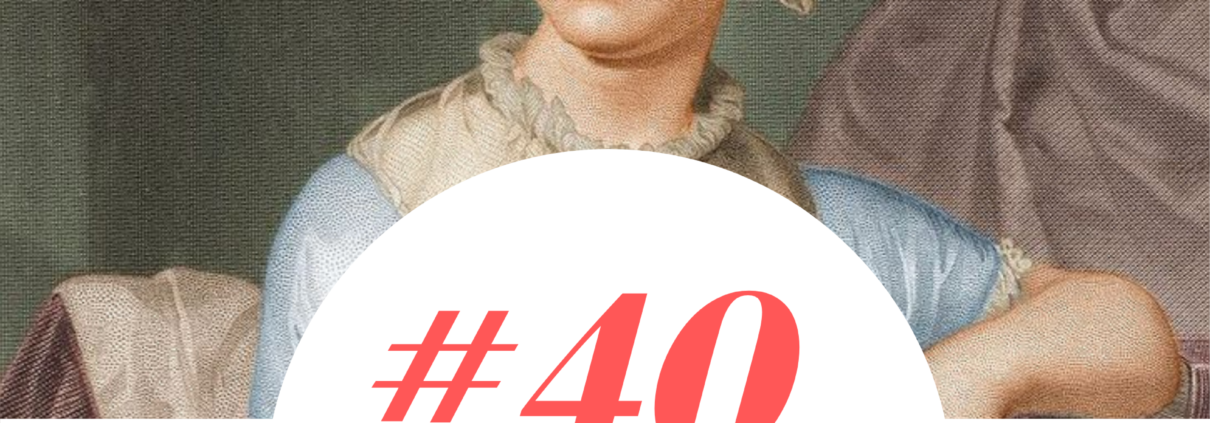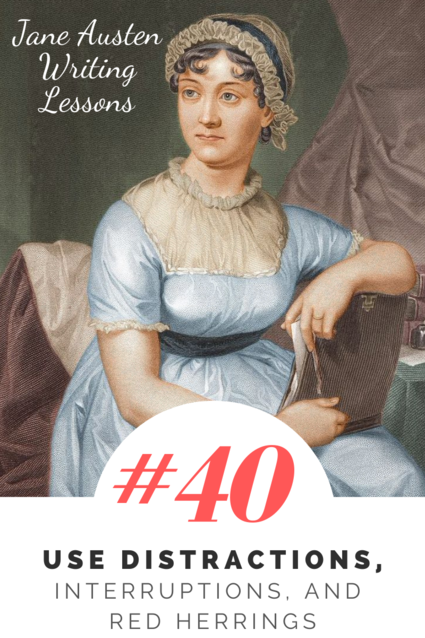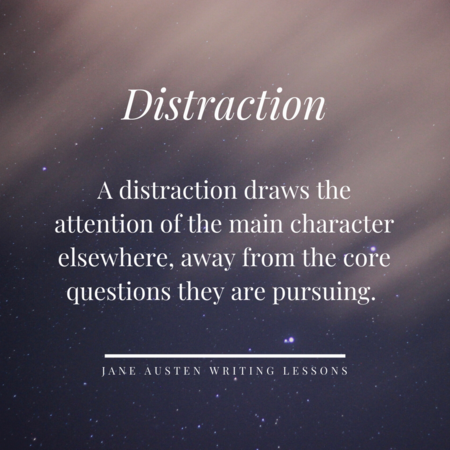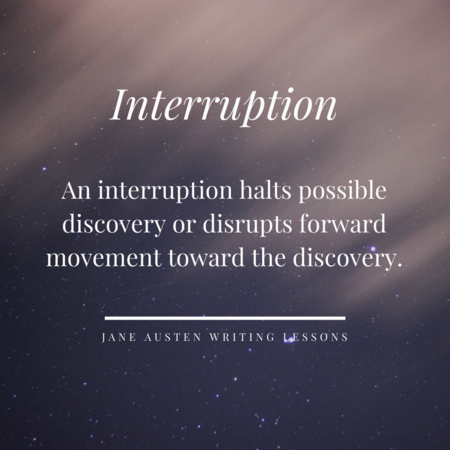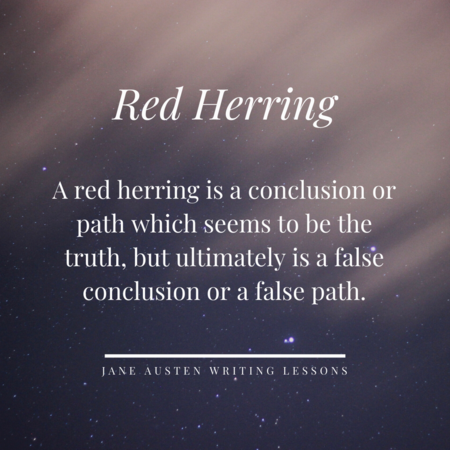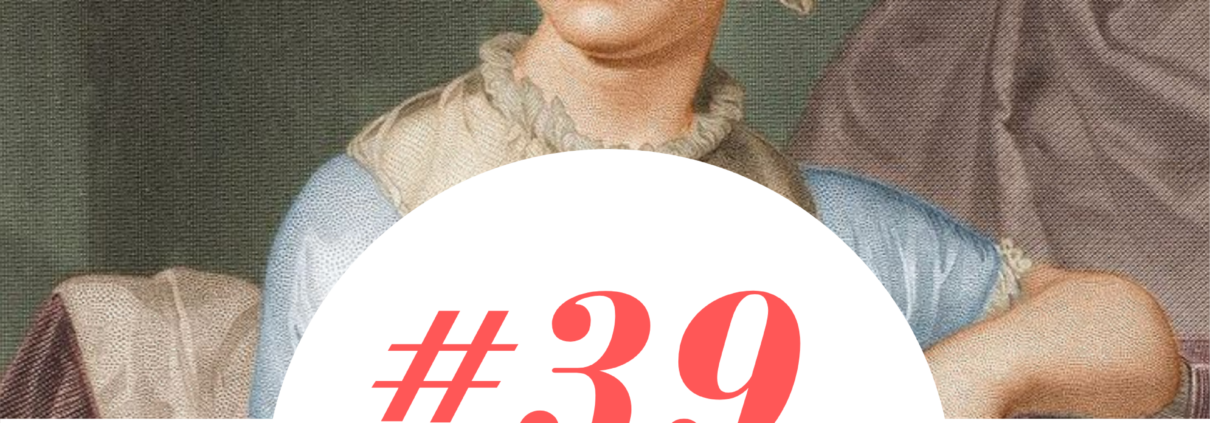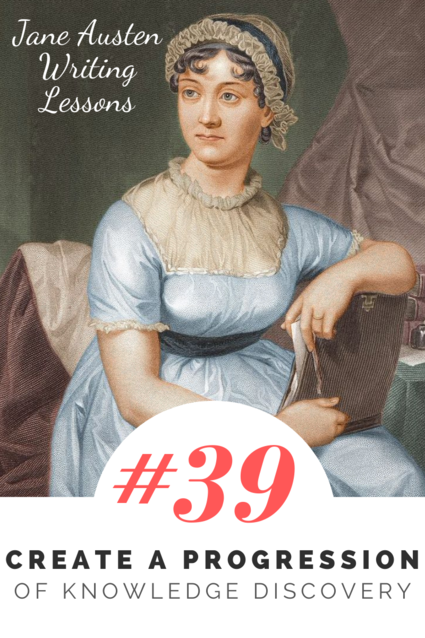#40: Use Distractions, Interruptions, and Red Herrings
If a character is seeking to discover something and she immediately discovers it fully and completely, then there is no story. For a story is about the journey, it is about the process, it is about the striving.
In the novel Persuasion, Anne Elliot has various questions that she seeks answers for, various things that she seeks to discover.
The initial question presented in the first few chapters of the book is:
- How can her family financially survive?
As this question is established, so are larger questions:
- What is Anne’s place in the world and her family?
- What will Anne’s future look like?
These two questions are big questions, which require large discoveries: they are asking fundamental questions about her identity, who she is, and who she wants to become.
In fiction, discovery is often about answering the fundamental questions of self. Yet it is difficult to “know thyself” and it is difficult to change and progress and become. As such, the discovery of answers to these fundamental questions should be difficult for characters.
Related to these fundamental questions in Persuasion are questions about relationships:
- Does Anne still have feelings for Captain Wentworth?
- Does Captain Wentworth have feelings for Anne?
- Can Anne and Wentworth reconcile?
While questions 2 and 3 relate largely to Anne’s internal journey, questions 4-6 related to Anne’s external journey. These questions are related to the larger plot arc of the story, and, once again, must be challenging to answer, or they would not be strong enough questions to sustain an entire novel.
Yet as a writer, how do you make discovery difficult for your characters? Jane Austen makes discovery difficult through three primary methods:
- Requiring a progression of knowledge discovery—knowledge that requires multiples steps to gain, or multiple types of knowledge.
- Using antagonists who interfere with the discovery process.
- Creating distractions, interruptions, and red herrings, all which make discovering the true answers more difficult.
We’ve discussed discovery progression and antagonists in other posts, so in this post we’ll discuss how to use distractions, interruptions, and red herrings.
Distractions
A distraction draws the attention of the main character elsewhere, away from the core questions they are pursuing.
Two of the distractions in Persuasion come in the form of two other gentlemen who are interested in Anne Elliot: Captain Benwick and her cousin, Mr. Elliot.
The first time that Anne sees her cousin, Mr. Elliot, she does not know who he is:
When they came to the steps, leading upwards from the beach, a gentleman at the same moment preparing to come down, politely drew back, and stopped to give them way. They ascended and passed him; and as they passed, Anne’s face caught his eye, and he looked at her with a degree of earnest admiration, which she could not be insensible of….It was evident that the gentleman, (completely a gentleman in manner) admired her exceedingly.
The interest of Captain Benwick and Mr. Elliot help her in her quest of answering the second and third questions: What is her place in the world and her family? What will her future look like? With them, she can visualize different possible futures and different possible roles.
On the surface, the time and attention she pays to Captain Benwick and Mr. Elliot is a distraction from asking the three key questions regarding the plot—whether Anne still likes Captain Wentworth, whether Captain Wentworth likes Anne, and whether or not they can reconcile.
Yet in the hands of a master like Austen, distractions do not simply draw away the character’s attention from their process of discovery.
These distractions ultimately help Anne consider what it that she wants. Her interactions with these men help her choose the path of taking more initiative. Her interactions with Benwick and Elliot make her realize how much she still loves Wentworth. And finally, her interactions with Benwick and Elliot create jealousy within Wentworth, and help him realize that he has the risk of losing Anne.
Good distractions help the character learn and act in ways that will ultimately help them in the discovery process.
Interruptions
An interruption halts possible discovery or disrupts forward movement toward the discovery.
After Anne sees her cousin Mr. Elliot for the first time, and Mr. Elliot admires her, there is a key moment between Anne and Captain Wentworth:
Captain Wentworth looked round at her instantly in a way which shewed his noticing of it. He gave her a momentary glance—a glance of brightness, which seemed to say, ‘That man is struck with you,–and even I, at this moment, see something like Anne Elliot again.’
These two sentences open the possibility of future discovery about and between Anne and Captain Wentworth. Both Anne and Wentworth are more aware of each other, and Captain Wentworth seems to remember his interest in Anne. If an interruption had not occurred, they might have resolved their past and their future much more quickly.
But an interruption does occur:
Louisa falls and experiences a head injury. As a result, Anne returns to her family, and it also places Captain Wentworth in a position of obligation with Louisa. He has been pursuing her, and now that she is injured, he cannot simply begin pursuing Anne: his duty as a gentleman demands that he continue to assist Louisa, and even potentially become engaged to her.
When Anne returns to live with her father and older sister, she goes from being in a group that appreciates and understands her to being largely unappreciated and misunderstood. Yet she does not wallow in inactivity, for instance, spending time with her friend Mrs. Smith even though her family disapproves of it.
Wentworth is able to see more fully the result of his actions. When Louisa becomes engaged to someone else, he is free to choose anew what he wants, and he begins more actively reestablishing a relationship with Anne.
Interruptions create hardships or difficulties for characters, often in ways that help them grow internally.
Red Herrings
A red herring is a conclusion or path which seems to be the truth, but ultimately is a false conclusion or a false path.
Earlier in the novel Persuasion, Anne follows a red herring. She sees Captain Wentworth’s pursuit of Louisa and concludes that Captain Wentworth has completely moved on from their relationship. She believes that he feels nothing for her, and that there is no possibility of a future between them.
Anne did not wish for more of such looks and speeches. His cold politeness, his ceremonious grace, were worse than any thing.
In this first half of the novel, Anne is quiet and unassertive, and she does not pursue her interests, in part because of her belief in this red herring.
Jane Austen’s novel Emma arguably uses more red herrings than any of her other novels. Emma consistently notices the wrong things about people, which leads her to great trouble in relationships. She takes clues and carries them to false conclusions, and then she pursues these red herrings relentlessly, which blinds her to the truths and the real clues around her.
For instance, when she paints a portrait of her friend Harriet, Mr. Elton excitedly offers to have the portrait framed in London. Emma takes this as a clue for Mr. Elton’s interest in Harriet, and does everything to set up a relationship between Elton and Harriet. Yet this is a red herring. Mr. Elton is interested in Emma, and it was for this reason that he was enthusiastic about the portrait.
Red herrings make it more difficult to find the truth, creating internal and external obstacles that the character must overcome in order to continue the path of discovery.
Conclusion
Distractions, interruptions, and red herrings are essential elements of storytelling. They don’t exist simply to make the story take longer. They exist because struggle is essential for refining character, and because the things that characters most want and need should be initially outside of their grasp if they are truly worth seeking.
Exercise 1:
Write out answers to these questions about your personal life:
- What everyday things distract you from your goals? Is there a time when you have had a larger distraction from your goals?
- What sort of everyday interruptions do you experience? What is a large interruption you have experienced which has halted for a time or changed the progression of your life?
- Are there any times in your life when you have come to false conclusions, or headed down a path that seemed like the right path but turned out to be the wrong one?
- What can you learn about distractions, interruptions, and red herrings from your own personal life that you can apply to writing fiction?
Exercise 2:
Take a scene that you have written and add a distraction, interruption, or red herring to it. (Or, if you’d like, you can add more than one!) This distraction, interruption, or red herring can be small and localized (and could potentially be overcome by the end of the scene), or it could be larger, with implications for later in the story.
Exercise 3:
Picture the classic character of Little Red Riding Hood, who desires to visit her grandmother in the woods. Set a timer for 5 to 10 minutes, and create a list of as many possible distractions, interruptions, and red herrings that she could encounter on her journey. This list can include those in the original tale, but should not be limited to them. Circle the three ideas that seem the most interesting to you.
Bonus: Write a new version of the Little Red Riding Hood story using your chosen distractions/interruptions/red herrings.

